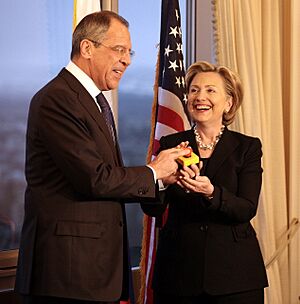Russian reset facts for kids
The Russian reset was a plan by the Obama government to make friends again with Russia between 2009 and 2013. It aimed to improve the relationship between the two powerful countries.
Contents
The Symbolic Reset Button
On March 6, 2009, in Geneva, U.S. Secretary of State Hillary Clinton met with Russian Foreign Minister Sergey Lavrov. She gave him a special red button. The button had the English word "reset" and a Russian word that was supposed to mean "reset."
A Small Mistake with a Big Meaning
The Russian word on the button was "peregruzka," which actually means "overload." The correct Russian word for "reset" is "perezagruzka." Also, the button looked like an emergency stop button used in factories. Even with this small mistake, Russian diplomats were happy that Hillary Clinton handled it politely. Both Lavrov and Clinton pushed the button together. It was a symbol of their hope for a new start.
Working Towards Better Relations
Before the reset, the relationship between the U.S. and Russia was difficult. This was partly because of a conflict in 2008 between Russia and Georgia. Some officials in the Obama government were not sure if the reset would work. They thought it might be too hopeful.
Key Steps in the Reset
- Helping in Afghanistan: In July 2009, Russian President Dmitry Medvedev allowed U.S. planes and supplies to fly over Russia to reach Afghanistan. This was a big help for U.S. troops.
- Missile Defense Plans Changed: On September 17, 2009, U.S. President Barack Obama announced a change. The U.S. would not build a missile defense system in Eastern Europe as planned earlier. Russia had seen this system as a threat. Vladimir Putin called this decision "correct and brave."
- Reducing Nuclear Weapons: In March 2010, the U.S. and Russia agreed to reduce the number of nuclear weapons they each had. This was a major step for global safety.
- Sanctions Against Iran: In May 2010, big countries like the U.S., China, and Russia agreed to put sanctions (penalties) on Iran. This was to stop Iran from developing nuclear weapons. Soon after, the U.S. removed its own sanctions on a Russian company that sold weapons to Iran.

Challenges and Setbacks
In 2012, the U.S. passed a law called the Magnitsky Act. This law put sanctions on some Russian officials. In response, Russia passed a law that stopped Americans from adopting Russian children. Russia also made a list of U.S. officials who could not enter Russia.
At a meeting in 2015, then-Vice President Joe Biden talked about the reset. He said that between 2009 and 2012, a lot was achieved with Russia. This included:
- A new treaty that cut nuclear weapons by one-third.
- Important supply routes for troops in Afghanistan.
- Agreements at the United Nations to pressure North Korea and Iran.
Biden also said that everyone hoped Russia would become more connected to the world economy. He mentioned that Russia joined groups like the Council of Europe and the WTO. However, he also said that President Putin had chosen a "different path."
When Relations Got Worse
By March 2014, many people in the news said the reset had "failed." This was because Russia took over Crimea from Ukraine. There was also unrest in Ukraine that Russia supported. Russia also did not cooperate with the U.S. on issues in Syria.
Criticism and Defense of the Reset
Some politicians, like former Polish Minister of Foreign Affairs Adam Rotfeld, said the reset showed "weakness." Jeb Bush also called it a failure. He said Russia had "invaded Ukraine" (though this happened after the reset). He also said that being too "nuanced" with Putin could encourage bad behavior. The President of Lithuania, Dalia Grybauskaitė, even refused to meet President Obama in 2010 because she disagreed with the reset.
However, Hillary Clinton defended the reset. She called it a "brilliant stroke." She pointed to Russia's agreement on sanctions against Iran and allowing flights over its territory for troops in Afghanistan.
New Problems and Sanctions
In October 2014, Russian Prime Minister Medvedev said that a new reset with the U.S. was "impossible." He said relations were hurt by "destructive" and "stupid" international sanctions against Russia. These sanctions were put in place because of the conflict in Ukraine and the shooting down of Malaysia Airlines Flight 17. Western countries said this plane was hit by a missile from Russian-controlled territory.
Cyber Attacks and Military Incidents
In April 2015, news reports said that Russian hackers had gotten into important computer systems at the White House. U.S. intelligence agencies called these attacks "among the most sophisticated attacks ever."
In April 2016, two Russian jets flew very close to a U.S. Navy ship, the USS Donald Cook. They flew over the ship almost a dozen times. At one point, they were only about 9 meters (30 feet) away. The jets did not have any visible weapons, and the ship did not take any action.
This sharp worsening of relations has been called Cold War II by some people.


